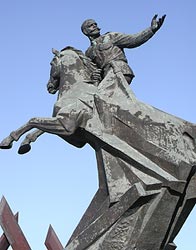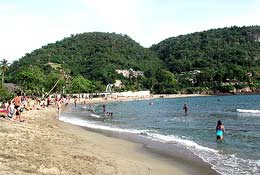|
Santiago
de Cuba and Environs
| Santiago
de Cuba is called "The Heroic City." Fidel Castro officially
gave the city this designation in 1984, the only place in Cuba to
be so honored. Santiago has been a center of resistance in all of
Cuba's independence struggles. The city's motto is "Rebellious
yesterday, hospitable today, heroic always." This downtown
building bears the image of Camilo Cienfuegos, one of the most popular
heroes of the Cuban Revolution. |
 |
 |
In
Santiago de Cuba, the cultures of Africa and Europe have created
a darker, richer brew than anywhere else in Cuba.There are museums
and galleries, some magnificent architecture, a picturesque if tattered
colonial core, and great traditional music. Touring the city by
bike is daunting at first because of traffic congestion and pollution.
However, it is not as dangerous as it initially seems, thanks to
the fact that Cuban drivers are used to cyclists in their midst.
A monument to Antonio Maceo, Cuba's greatest 19th-century military
hero, dominates the Plaza de La Revolucion. |
| If
downtown Santiago de Cuba is not ideal for cycling, it is still
a great hub from which to begin your explorations of the Oriente.
One-day cycle outings include a ride to Cuba's most-visited church,
the Iglesia de La Caridad del Cobre, the shrine of Cuba's patron
saint. We also enjoy riding to El Christo, a nearby country town,
and to El Morro, a Spanish colonial fort that guards the entrance
to the bay. |
 |
 |
Our
favorite cycle outing from Santiago de Cuba goes to Granita Siboney,
a virtual shrine of the Cuban Revolution, to the beach at Siboney,
and to the Bacanao Reserve, a huge area that has been recognized
by UNESCO for its biodiversity. There are more sites of historic
importance packed into this 50-kilometer out-and-back ride than
into any other of similar length that we know. |
|




